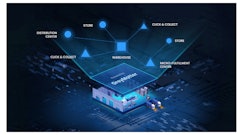
Infrastructure-free, while it’s a mouthful, is one of the hottest terms in the supply chain visibility space today. Increasingly businesses are looking for a visibility solution that does not require the hassle and expense of installing RFID or Bluetooth gateways throughout their network. And ideally, that solution enables piece-level tracking without the physical infrastructure.
Cellular-based tracking has the promise of delivering a gateway-free infrastructure solution. However, cellular-based tracking devices have been expensive, bulky, and require the hassle of reverse logistics as well as creating e-waste. Historically, this technology was mostly leveraged for tracking high-end products prone to theft such as new technology releases, TVs, e-bikes, laptops, smartphones, etc.
Fast forward to today when the prices have come down on the electronics that go into cellular tracking devices. And the parts themselves are now small enough so that ultra-thin circuits, chips and batteries can exist on the same substrate. The battery chemistry itself has evolved so that safe, non-hazardous power sources can power a cellular tracker device replacing lithium, the industry standard. Both the thinness of the technology and the environmentally improved battery, enables a cellular tracking device to come in the form of a printable label that is not dangerous goods and can be disposed of in normal waste streams.
The printability makes the smart label scalable as it can replace an existing shipping label and automates the association of a shipment reference to the smart label’s unique identifier. The fact that it is as thin as a label, makes the tracking device discrete and not visibly obvious that it is being tracked. Activation methods can range from tear-to-activate, print-to-activate, to tap-to-activate, giving a customer many options for how to deploy the cellular tracking smart label into their operations or services.
With prices coming down dramatically on cellular-based tracking devices, the economics are shifting so that it is financially possible to put trackers on more products beyond high-end, high-value, high-theft freight. With cellular-based visibility, operational processes of performing manual audits, scanning barcodes, walking through a warehouse to read RFIDs, or having forklifts drive through a gateway tunnel, are replaced. Instead, businesses can realize the value of real-time visibility on every tracked piece as it moves through the supply chain.
With this new class of cellular trackers, as long as there is solid cellular reception, companies now can know exactly where each piece is without the burden of installing gateways. There are several providers that offer close-to label-thin or truly label-thin tracking devices. Each has their own strategies for location determination, activation method, battery chemistry and battery length.
To date, the companies that have been the most excited about “going infrastructure-free” are businesses who need to know if their products are making it to and when necessary, staying at their intended destinations. Companies that rely on products being shipped to locations that are out of their control and have no independent way of knowing if their products are being received and handled correctly are most keen on infrastructure-free track solutions. The demand is high in business-to-business and business-to-consumer markets where precise location of a shipment is critical- like in pharmaceuticals, e-commerce and distribution to retailer supply chains.
With the ability to track more items cost-effectively in an infrastructure-free environment, more data will be available and collected in a consistent way throughout a package’s supply chain journey. With good, reliable data and one consistent source of truth, the industry can benefit from leveraging more sophisticated technology, such as machine learning, to automate processes and apply logic like advanced routing, to reroute a shipment through a different corridor or carrier if a particular region is experiencing congestion, delays, miss routes, lost product.
For a number of reasons, there is a growing weariness of requiring data gateways to track products through the supply chain. Until now, the technology hasn’t existed to enable infrastructure-free tracking at a price point that was economical for a majority of products moved. That will change in the year ahead and has the potential to greatly improve the efficiency and visibility of supply chain processes.


















